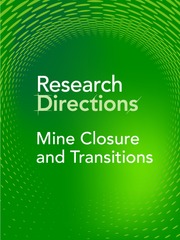-
- You have access: full
- Open access
- ISSN: 2753-3999 (Online)
Co-Editors-in-Chief: Professor Thomas Baumgartl, Federation University | Australia and Professor Guy Boggs, University of Western Australia | Australia
Research Directions: Mine Closure and Transitions will have ceased publication at the end of 2025, and new submissions to the journal are no longer being accepted. All published materials will remain available through the Cambridge University Press platform in perpetuity.
Research Directions: Mine Closure & Transitions aims to investigate the ways in which mines are closed such that they deliver environmental, social, cultural and economic value. This will include examination of how closed mine sites and related assets can be repurposed, and how to enable Just Transitions for mining regions and communities through closure. The journal provides a vehicle for bringing new insights to international attention, promote new methods and tools that can underpin more rapid advances, draw attention to data that challenges existing orthodoxies and encourage the sharing of novel research findings from many disciplines that are most relevant to resolving critical uncertainties. With growing societal and investor expectations, and decarbonisation driving transitions across the globe, its critical that we focus on what information is required to answer the most pressing questions that matter most to those most affected. The journal will connect academia and industry, providing rapid access to research findings regarding applied, scientifically complex problems to meet societal expectations and demands and help the mining industry contribute to achieving the sustainable development goals.
Research Directions: Mine Closure and Transitions will have ceased publication at the end of 2025, and new submissions to the journal are no longer being accepted. All published materials will remain available through the Cambridge University Press platform in perpetuity.
Research Directions: Mine Closure & Transitions aims to investigate the ways in which mines are closed such that they deliver environmental, social, cultural and economic value. This will include examination of how closed mine sites and related assets can be repurposed, and how to enable Just Transitions for mining regions and communities through closure. The journal provides a vehicle for bringing new insights to international attention, promote new methods and tools that can underpin more rapid advances, draw attention to data that challenges existing orthodoxies and encourage the sharing of novel research findings from many disciplines that are most relevant to resolving critical uncertainties. With growing societal and investor expectations, and decarbonisation driving transitions across the globe, its critical that we focus on what information is required to answer the most pressing questions that matter most to those most affected. The journal will connect academia and industry, providing rapid access to research findings regarding applied, scientifically complex problems to meet societal expectations and demands and help the mining industry contribute to achieving the sustainable development goals.


Meet the Co-Editor-in-Chief
Meet the Co-Editor-in-Chief